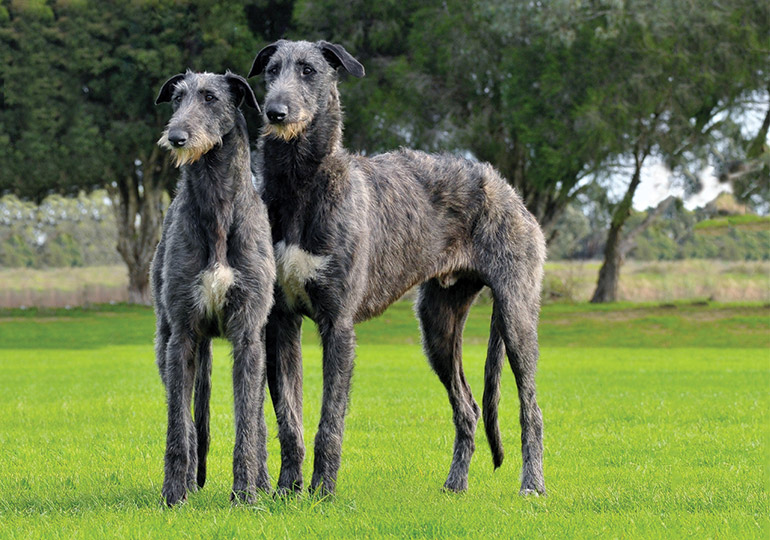Deerhound
Breed Details
Size:
Exercise Requirements:
Grooming Requirements:
30-48 Kg (Approx)
9-10 years (Approx)

Appearance
Deerhounds are part of the sighthound family and in appearance should resemble a greyhound of larger size and bone. Their rough, wiry coat comes in various shades of grey. It is easily managed and does not readily harbour dirt. Size is desirable in this breed and a Deerhound should be as tall as possible, consistent with quality.
Height should be not less than 76cm (30”) at the shoulder for males, and 71cm (28”) for females. Dogs should weigh 39-48kg, bitches 30-37kg.
History
The Deerhound, the Royal Dog of Scotland, has been bred in the Highlands and Western Isles of Scotland since time immemorial. It is undoubtedly true that it is one of the oldest, if not the oldest, British breeds of dog. Bred to run down, catch and kill red deer, the Deerhound is built for speed and stamina. Revered for his courage and tenacity as a stag hunter, it was not until the introduction of improved firearms that their skills were no longer in great demand.
Deerhounds have been in Australia since early colonial times and played an important part in the development of this country. Certainly there is mention of Deerhounds in records as early as 1860 and they are depicted in our emerging colonial art.
In the early days, they were in demand as a companion and for hunting kangaroos as a source of much needed food for settlers. Later, as pastoralists moved further west, they were used for killing dingo and foxes that preyed upon the sheep flocks. Frequently, they were used as station sires and the Kangaroo Dog developed. Wealthy squatters even established their own deer parks.
Temperament
The Deerhound is loyal, dignified and adores children. They are sweet, tractable, lazy dogs, not excelling in obedience work.
They like to be close to their family and will feel rejected if banished outside. If a Deerhound is to be an outdoor dog, it needs to be provided with a draught-free kennel, not too far from the house. They are busy as a puppy and prone to long naps as an adult. Some Deerhounds can be extremely sensitive and need almost no disciplining, whereas others try your patience to the limit.
Please note: if a Deerhound is not given infinite companionship and direction as a youngster, it can develop into a headstrong, boisterous and unruly adult.
Deerhounds are wonderful dogs for those who have a large, safely fenced area to exercise in and who do not spend long hours away from home on a regular basis. Adults enjoy as much exercise as you can give them. A young puppy will exercise sufficiently just playing with the family, itself or other dogs each day. They are probably not going to bring back the stick that you throw and most likely will not bark and growl when someone approaches your front door. That nice roast you put on the kitchen counter to defrost is an open invitation for a Deerhound to snack.
A Deerhound should live happily with other household pets. However, since they were bred to chase and catch game, the sight of a small animal running by may trigger a response. Your Deerhound may share companionship with your indoor cat, but may change its attitude outside when a cat, even its indoor cat, runs past. Most owners report their Deerhounds and other pets get along just fine, but it is best to use caution to prevent any “chasing mishaps”.
Owners need to accommodate a Deerhound’s size, need for exercise, quality food and good health care. In return you will have a faithful companion, who will reward you with love and devotion throughout its life.
Those who share their lives with Deerhounds wonder why they are not more popular, but the Deerhound is really not for everyone.
Care/Grooming
Deerhounds are basically a healthy breed. Apart from bloat and cardiomyopathy that are common to all deep-chested, giant breeds, there are few health issues. Deerhounds can live to be 9 or 10 years old, sometimes more. They are long lived for a giant breed; females tending to live longer than the males.
Scottish Deerhound's harsh, somewhat wiry coat is very easy to care for, requiring only an all-over brushing and combing every week or so. He will also need a trim of his nails every few weeks if they aren't worn down naturally. Grooming tools to have on hand include a slicker brush, a fine-toothed metal dog comb, and an electric nail grinder or a pair of heavy-duty dog nail clippers.

